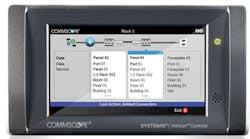TIA to publish updated administration standard and new AIM standard concurrently
By Patrick McLaughlin
The Telecommunications Industry Association’s (TIA) Subcommittee TR-42.6, Telecommunications Infrastructure and Equipment Administration, is poised to publish two standards simultaneously in the coming months. At the group’s most recent meeting held in early February, it resolved all outstanding comments on the “C” revision of the ANSI/TIA-606 Telecommunications Infrastructure and Equipment Administration standard. At the same meeting, the subcommittee made significant strides toward publishing ANSI/TIA-5048, which is an adaption of the ISO/IEC 18598 standard titled Automated Infrastructure Management (AIM) Systems - Requirements, Data Exchange and Applications.
To say the TIA will “adapt” ISO/IEC 18598 means that the standards body will publish the existing standard nearly verbatim as ANSI/TIA-5048. Nearly verbatim. The one alteration TR-42.6 will make to the ISO/IEC standard is the requirement that an AIM system will accommodate an identification scheme that complies with the forthcoming ANSI/TIA-606-C.
Taking AIM
In May 2016, once the ISO/IEC 18598 standard had become a stable document, CommScope’s (www.commscope.com) European building solution architect, Dr. T.C. Tan, wrote that with that milestone achieved, “network infrastructure managers should seriously consider deploying an AIM system … in their data centers and offices.”
The standard, he explained, is technology-agnostic and covers an integrated hardware and software system that accomplishes the following: “automatically detects the insertion or removal of cords; documents the cabling infrastructure including connected equipment; and enables management of the infrastructure and data exchange with other systems.”
Further, Dr. Tan noted, the standard includes a clause that describes intrinsic and extrinsic business benefits of deploying an AIM system. “The intrinsic benefits include accurate documentation (auto-documentation of physical layer connectivity), change/incident/capacity management (monitoring and management of connectivity changes), and asset management (discovery of devices connected to the network and location information for connected devices).
“The extrinsic benefits cover either application program interfaces (APIs) or data exchange between an AIM system and other business information or network management systems that can provide enhanced functionality to both systems,” he noted. “It addresses data exchange format, protocols and commands, and defines a common data model describing elements and assets contained within an AIM system. These include data exchange format and protocols according to Simple Object Access Protocol (SOAP) or RESTful-based web services, and a basic set of commands.”
Tan emphasized that an AIM system’s extrinsic benefits will be of particular interest to the construction industry and building owners, as building information modeling (BIM) is being mandated by some governments, including the United Kingdom, Finland, Norway, the Netherlands and Singapore. “The AIM system will enhance the functionality of BIM in the areas of asset information management, space utilization and location-based energy management policies,” he explained. This is definitely food for thought, as the physical network infrastructure (for information) can be considered as a fourth utility in the office environment, along with piping (for water), mains cabling (for power) and ducting (for HVAC).”
Annexes and how-to
The ANSI/TIA-5048 standard includes four annexes, three of which are informative and one of which is normative. Informative information is included in Annex A, Hierarchy and Containment Rules; Annex B, Field Descriptions, and Annex D, Optional Lower Level Data Exchange Framework.
Annex C, titled Implementation Requirements and Recommendations, is normative. That annex states, “There are four phases in the successful implementation of information technology cabling that are also applicable to AIM systems: design, specification, installation, operation.” The rest of the annex prescribes those four phases. For example, it reads, “Design of the AIM system should be undertaken in consultation with a) the cabling system designer, b) the customer to determine required features, c) other business systems that are intended to exchange data, d) network administrators.”
TIA-606-C
The update of the ANSI/TIA-606 standard from its “B” to its “C” revision has been a quick process by standards-development perspectives. In its June 2016 meeting, TR-42.6 approved a project request to initiate work on 606-C. At the same meeting, the committee approved a 45-day committee ballot for the standard. At its October 2016 meeting, the committee resolved a round of comments on the document and approved an industry ballot for it.
Then at its meeting in February, TR-42.6 resolved comments arising from the most recent ballot and approved a default ballot. The committee also approved the standard’s publication, provided there are not technical comments or negative votes resulting from the default ballot, with the contingency that it must publish concurrently with TIA-5048.
The changes from the “B” version to the “C” version are relatively few, but are worth noting.
Commonly, when a TIA standard is revised, addenda that had been made to the previous revision get incorporated into the current revision. A different approach was taken here. The lone addendum to ANSI/TIA-606-B, published in 2015, addressed AIM and harmonized with the ISO/IEC 14763-2-1 standard. As has been detailed in this article, ISO/IEC more recently addressed AIM with its 18598 standard, which the TIA is adapting as ANSI/TIA-5048. Therefore, TIA-606-C, rather than incorporating the content of 606-B Addendum 1, will reference ANSI/TIA-5048.
Also new in the 606-C standard will be an Annex D, which will be informative and will provide guidelines for administering cabling that supports remote powering. That annex will include guidelines for cable bundle identification.
Other modifications in 606-C include changes to the identifier scheme for telecommunications grounding and bonding system elements. These changes will specify the use of terms compatible with ISO/IEC 30129. Legacy terms used in versions of the TIA-607 standard earlier than revision C also will be allowed.
Specifically, these changes include use of the term “TBC” (telecommunications bonding conductor) instead of “BCT” (bonding conductor for telecommunications), “RBB” (rack bonding busbar) instead of “RGB” (rack grounding busbar), “BBC” (backbone bonding conductor) instead of “GE” (grouding equalizer), “SBB” (secondary bonding busbar) instead of “TGB” (telecommunications grounding busbar), and “PBB” (primary bonding busbar) instead of “TMGB” (telecommunications main grounding busbar).
Patrick McLaughlin is our chief editor.
